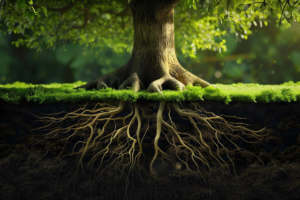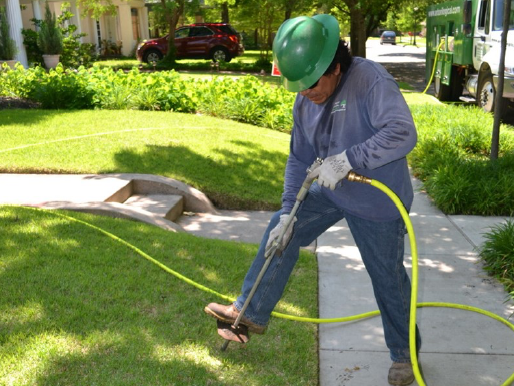Would you like to restore vitality to your trees or bring brightness to your hedges or shrubs?
Bio-Contrôle Arboricole offers using an exclusive blend of water-soluble fertilizers and mycorrhizae.
Invest in the health of your trees now to enjoy their benefits for a long time to come!
We offer fertilization services in the Greater Montreal area and elsewhere in Quebec upon request.
The cost of fertilization varies depending on the diameter of the tree or shrub canopy.
Contact us quickly to discuss your needs and our rates.
Does your tree or shrub need fertilization by injection?
Here are some signs that may indicate a nutrient deficiency and that they need a boost:
- Slow or almost no growth
- Reduced leaf size and/or loss of foliage
- Branches that appear less vigorous
- Discolored leaves, losing their natural green.
Root Fertilization by Injection
Why perform root fertilization by injection for trees and shrubs?
Trees and shrubs need nutrients to promote their growth and well-being. Over time, the soil can degrade because we collect leaves from our yards and most of the water is drained into the sewers. As a result, the soil may no longer provide the necessary nutrients for trees and shrubs. To prevent nutrient deficiency, root fertilization by injection is the most effective solution. This method allows trees and shrubs to absorb more nutrients, which helps strengthen their health and vitality.
Benefits of fertilizer on trees and shrubs:
With root fertilization by injection, your trees and shrubs will be more resistant to certain diseases and insect infestations, which in turn helps them perform their role in the recovery of greenhouse gases (GHG).
Spring fertilization stimulates faster and more vigorous regrowth of trees and shrubs. Autumn fertilization helps store the energy required to better withstand winter and potential cold-related injuries.
Fertilization stimulates root growth, which makes it easier to absorb nutrients and water from the soil. Fertilization is especially beneficial for fruit trees, as it promotes better flower and fruit production. *Even more effective with Mycorrhizae*
What is root fertilization by injection?
It involves injecting fertilizer directly into the soil at the root level of trees and shrubs. The liquid fertilizer is specially designed to release its nutrients progressively. This ensures that trees and shrubs receive a balanced and complete fertilization throughout the summer season.
Best time to fertilize trees:
It is beneficial to fertilize trees in both spring and autumn since the benefits differ according to the season. We avoid fertilizing conifers and deciduous trees after the end of June and July respectively, to avoid encouraging new growth and allow the tree to focus on preparing for the cold season ahead.
Fertilization frequency:
- Young and growing tree or shrub: In its first years, the tree is particularly vulnerable to deficiencies, weather conditions, diseases, and pests. To ensure optimal growth and good vitality, annual fertilization is essential.
- Mature tree or shrub: A mature, healthy tree has a well-developed root system capable of extracting nutrients deep into the soil. It typically does not require annual fertilization, especially in soils where leaves are left in place during autumn. As a general rule, fertilization every two years is sufficient.
- Exception for damaged trees or shrubs: For winter damage, it is recommended to fertilize the tree or shrub in spring before leaf budbreak. For damage (broken branch, pruning, or other types of injury) during the growing season, it is helpful to fertilize the tree or shrub in autumn. This helps the weakened tree or shrub better face the winter.
Root fertilization by injection vs. granular fertilization and implant fertilization:
Root fertilization by injection concentrates the fertilizer directly where the root mass is located. This greatly reduces the loss caused by runoff. A large part of the fertilizer will be absorbed by the lawn or other nearby plants when the fertilizer is in granular form. Implant fertilization is injected directly into the tree trunk, limiting runoff, but the holes made to inject the fertilizer in this way cause injuries that induce stress to the tree or shrub. For these reasons, we recommend root fertilization by injection over other methods.
Mycorrhizae
Why use mycorrhizae?
Mycorrhizae are a fungi that form a symbiotic relationship with the roots of trees, shrubs, and plants. Using them brings benefits to the tree, shrub, or plant with which they are used.
- Improvement of nutrient absorption such as nitrogen, phosphorus, potassium, and others:
- Nitrogen: Stimulates tree growth since it is primarily found in chlorophyll and leaf proteins. A tree with sufficient nitrogen will have dark foliage.
- Phosphorus: Promotes root development, stimulates flowering, and aids fruit production in fruit trees.
- Potassium: Regulates vital functions in the plant, such as resistance to diseases, cold, and drought. It helps plants, especially hardy ones, better withstand winter.
- Strengthening of the root system: Helps trees and shrubs better stabilize themselves.
- Protection against pathogens: Mycorrhizae act as barriers against soil-borne pathogens, preventing them from infecting the tree’s roots. They can also produce substances that inhibit the growth of these pathogens.
- Resilience to environmental stress: Mycorrhizae help trees, shrubs, and plants better withstand drought, poor soils, or ecological disruptions by assisting in water and nutrient resource management.
- Promotion of growth: With better nutrition and increased protection, trees, shrubs, and plants colonized by mycorrhizae can experience faster and healthier growth.
In summary, mycorrhizae help trees and shrubs better absorb nutrients and water, maximizing their growth potential while protecting them against certain soil dangers. It is an excellent way to promote long-term health for trees and shrubs in diverse environments. Newly planted trees and shrubs show a significant increase in survival rates when mycorrhizae are used during or shortly after planting.
Combining Water-Soluble Fertilizer and Mycorrhizae: Even Better!
Why is combining root fertilization by injection with mycorrhizae beneficial for your trees and shrubs?
The synergy between root fertilization by injection and mycorrhizae offers a comprehensive and efficient approach to the health of your trees and shrubs. By injecting essential nutrients directly into the soil, root fertilization ensures quick and targeted nutrient absorption.
Mycorrhizae, on the other hand, form a network of fungal filaments that extend well beyond the roots, increasing the absorption surface and making nutrients and water more accessible, even in poor or degraded soils. Additionally, they improve the overall health of the soil by promoting microbial biodiversity and reducing the risk of root diseases.
By combining these two services, you benefit from both rapid nutrition and the lasting benefits that mycorrhizae provide to your trees and shrubs. Not only do your plants receive the nutrients they need, but they also enjoy a strengthened and resilient root system capable of better managing climatic stress and pathogen attacks. It’s an ideal solution for ensuring optimal and sustainable growth while preserving soil health and the surrounding ecosystem.
Our exclusive blend of water-soluble fertilizer and mycorrhizae will deliver the best results for the health and growth of your trees and shrubs.


